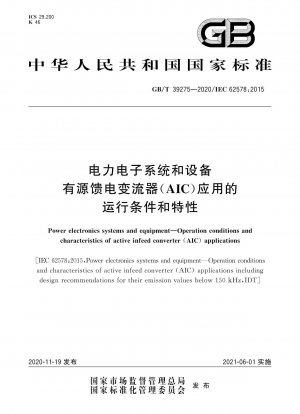GB 39275-2020
Operating conditions and characteristics of active infeed converter (AIC) applications in power electronic systems and equipment (English Version)
- Standard No.
- GB 39275-2020
- Language
- Chinese, Available in English version
- Release Date
- 2020
- Published By
- General Administration of Quality Supervision, Inspection and Quarantine of the People‘s Republic of China
- Latest
- GB 39275-2020
- Scope
- This standard describes the operating conditions and typical characteristics of active-fed converters (AICs) using various technologies and topologies, which can be connected between the AC side of the supply network (grid) and the DC side with constant current or voltage. And performs electric power (active and reactive) conversion in both forward and reverse (feedback) directions. Generally, active feed conversion needs to be combined with all voltage and power levels of speed-controlled electrical drive systems (PDS), uninterruptible power supply systems (CUPS), active filters, photovoltaic systems, wind power systems, and battery-supported power management systems. used together with the DC side. Active feed converters are usually connected between the power supply network (AC side) and the DC side of the current or voltage in order to avoid the generation of low-frequency harmonics (for example, frequencies below 1 kHz) by synthesizing sinusoidal AC currents. Some of them can also compensate for existing harmonic distortion for a given supply-side voltage. Moreover, they can adjust the power factor of the power supply network by transferring electrical power (active and reactive power) in both forward and reverse radiation (feedback) directions, which can save energy and stabilize the supply voltage in the system, or integrate renewable energy or The electrical energy storage device is coupled to the power supply network. This standard gives practical methods for analyzing the emission values of active feed converters in power supply networks. The method is based on the latest results of line impedance values in the 2 kHz to 9 kHz frequency band and the withstand capabilities of capacitors directly connected to the supply network. This leads to fundamental considerations for designing emission values below 150 kHz. The following are not within the scope of this standard - active UDC application design, development or further functional requirements, - parasitic components or poor electronic design in facilities and their treatment measures that lead to active feed converters interoperating with other equipment Possibility of interaction or influence; ——Overhead line supply network: lack of information (measurement) on its three-phase impedance. This may be the subject of a future release
GB 39275-2020 Referenced Document
- CISPR 16-1-1 Specification for radio disturbance and immunity measuring apparatus and methods – Part 1-1: Radio disturbance and immunity measuring apparatus – Measuring apparatus
- GB/T 39275 Power electronics systems and equipment—Operation conditions and characteristics of active infeed converter (AIC) applications
- IEC 61000-4-7:2002 Electromagnetic compatibility (EMC) - Part 4-7: Testing and measurement techniques; General guide on harmonics and interharmonics measurements and instrumentation, for power supply systems and equipment connected thereto
- IEC 61000-4-7:2002/Amd1 Electromagnetic compatibility (EMC) - Part 4-7: Testing and measurement techniques - General guide on harmonics and interharmonics measurements and instrumentation, for power supply systems and equipm
- IEC 62040-1 Uninterruptible power systems (UPS) - Part 1: Safety requirements*, 2021-05-20 Update
GB 39275-2020 history
- 2020 GB 39275-2020 Operating conditions and characteristics of active infeed converter (AIC) applications in power electronic systems and equipment
